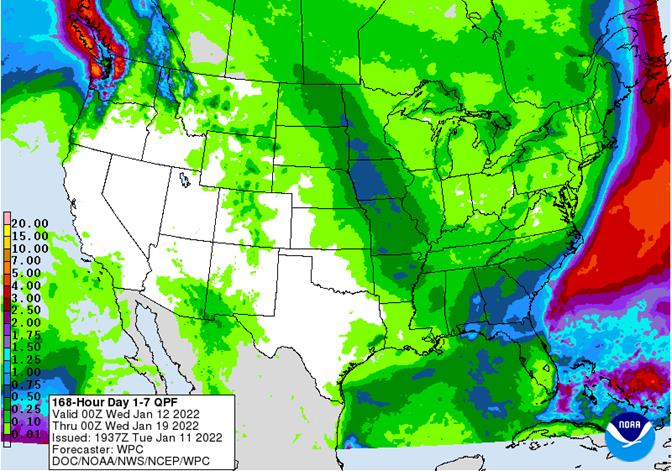PDF Attached
USDA:
Private exporters reported sales of 100,000 tons of soybeans for delivery to Mexico during the 2021/2022 marketing year. Soybeans ended mixed (bull spreading), soybean meal lower, and soybean oil higher. WTI crude oil was up nearly $3.00 by 1:15 pm CT and
the USD was 40 points lower. CBOT corn futures settled higher. Wheat futures are higher on follow through short covering and pickup in global import developments. Positioning was noted today. Conab reported a supportive Brazil corn production estimate and
bearish soybean output. The 1-7 US precipitation map is suggesting rain/snow at the back end of the forecast.

Weather
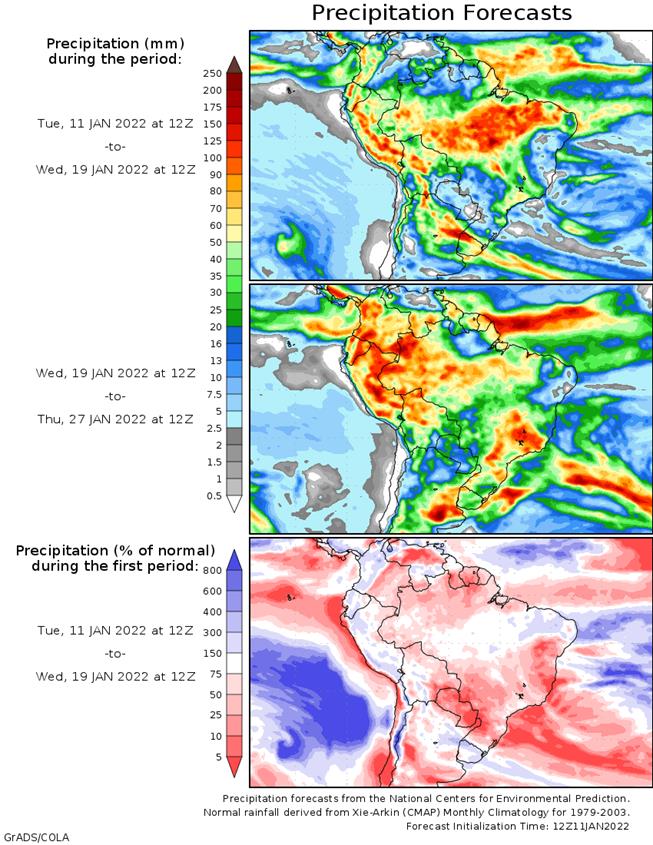
WEATHER
EVENTS AND FEATURES TO WATCH
- Argentina
crops are suffering from a daily increase in crop stress and damage to production because of no soil moisture, no rain and rising temperatures - The
next five days will be the most stressful to Argentina’s agriculture in recent years with extreme temperatures rising to between 108 and 115.
- Friday
and Saturday will be hottest with possibly one extreme reading of 117 - This
will be the hottest since January 23-24, 2014 and that heat wave was the worst in 53 years - Crop
areas north of southern Cordoba and southern Santa Fe may be in the worst condition except for some cotton areas in Formosa and Chaco where rain fell a little more significantly in December - Crops
in southern Cordoba, northeastern La Pampa, southeastern San Luis and from northwestern through central Buenos Aires had been in good condition prior to two weeks ago and stress has been steadily rising in the region as subsoil moisture has been depleted - The
arrival of hot temperatures the remainder of this week will more seriously stress these crops, but they have the best potential of revitalizing with the rain predicted next week - Late
season corn planting may resume with rain expected next week, although it is a little late for putting that crop into the ground - Some
replanting of crops might also occur, although it is too late for that - Livestock
stress will be high enough to reduce weight gains and milk production, but mostly in these next several days - Cooler
temperatures and rain expected late this weekend into next week should bring back a more favorable environment, although grazing grass development may need some time to recover - World
Weather, Inc. does not expect Argentina’s stressful weather to be as extreme again as that of this week, but there may be little more ridge building across a part of the nation late this month and in early February, but weather conditions in February will
gradually come back to a more normal pattern - Brazil
weather in the south has become less extreme outside of Rio Grande do Sul in recent weeks, but some lost production did occur in Parana, southern and western Mato Grosso do Sul and neighboring areas of Paraguay - Rio
Grande do Sul is still losing production potential because of dry soil and anticipated hotter temperatures - Some
relief is expected to for Rio Grande do Sul next week as rain from Argentina extends into a part of the state - The
relief may be abbreviated, but some follow up rain may come along a little later in the month - Too
much rain in eastern Mato Grosso, Tocantins, northern Goias and Minas Gerais is expected to end after the next couple of days - Much
lighter and more sporadic rainfall will occur from late this week through next week resulting in more hours of sunshine, warmer temperatures and better drying conditions between rain events - The
result will be improvements in crop and field conditions - Early
planted soybeans in Brazil are mostly produced farther to the west of the wetter biased areas and will experience good harvest weather over the next few weeks with Safrinha corn and cotton planting to evolve and advance well
- Rain
is expected to alternate with periods of sunshine in much of Brazil during the week next week and into the latter part of this month, although Rio Grande do Sul and neighboring areas could trend a little drier than usual again after a brief break from dryness - Temperatures
will be seasonable, but they will trend warmer over time. - U.S.
weather is expected to continue dry biased in the Great Plains and much of the western states during the next ten days with less rain in the interior Pacific Northwest as well - California
weather will bring some showers to the far north periodically, but most of the precipitation will be lighter than usual - A
succession of cool air masses will impact the central and eastern parts of North America beginning this weekend and continuing into next week bringing down average temperatures - A
cooler than usual bias will return to the northern Plains and upper Midwest - Precipitation
may be more limited in the eastern U.S. for a little while and the break will be welcome - The
GFS model is predicting a nor’easter for the weekend, but confidence is little low on both the timing and significance of that storm - New
South Wales, Australia will receive periodic showers and thunderstorms this week supporting cotton, sorghum and other summer crops - Rainfall
of 0.25 to 1.00 and a few 1.00 to 2.00-inch amounts are expected - Queensland,
Australia is unlikely to get much “meaningful” moisture this week, although a few showers will evolve - Greater
rain is needed for dryland production areas - Queensland
may continue to experience erratic rainfall as will New South Wales during the weekend and next week - Eastern
Australia could experience a boost in precipitation during the latter part of next week and if that evolves it would be a boon to the nation’s unirrigated summer crops and would bolster soil moisture and water supply for future irrigation - Australia
temperatures will be warmer than usual in western Queensland, western New South Wales and neighboring areas where rainfall may not be as great as needed to protect livestock grazing areas from further deterioration. - Rain
is needed on these areas - Australia’s
bottom line is one of needed rain in Queensland’s unirrigated grain, oilseed and cotton areas as well as all eastern Australia’s livestock country, but especially in the west. No serious changes to dryness in western parts of Queensland or New South Wales
during the next ten days. - South
Africa rainfall will be well distributed during the next two weeks with all crop areas impacted at one time or another - Yield
potentials remain high and “some” of the worry over wet weather diseases has been reduced with less rainfall recently - India
weather the remainder of this week will support more rain in east-central and southeastern parts of the nation expanding the area benefiting from recent significant moisture - The
precipitation will be greatest from southeastern Madhya Pradesh through Chhattisgarh into Odisha and northeastern Andhra Pradesh where rainfall will range from 0.75 inch to 2.00 inches with local totals over 3.00 inches
- Net
drying is expected elsewhere, but especially in the western half of the nation - Canada’s
Prairies turned a little warmer during the weekend and Monday with additional snow falling in many areas - Canada’s
southwestern Prairies are still drier than usual with moisture totals less than 0.25 inch over the next two weeks
- Snow
cover is still limited in east-central and southern Alberta and central, west-central and southwestern parts of Canada’s Prairies - This
is the most seriously drought stricken part of the Prairies and not much relief is likely prior to spring - Europe
precipitation during the next two weeks will be restricted especially in the western half to two-thirds of the continent
- Spain
and perhaps a part of Romania are the only areas that would benefit greatly from more significant precipitation, but restricted amounts are expected for a while - Soil
moisture is likely to be favorable across the continent during the next two weeks, despite limited precipitation - There
will be no threatening cold weather - Western
Russia, Belarus, Ukraine and Baltic States will get light and sporadic precipitation during the coming week with a boost in snow and a little rain next week - There
will be no threatening cold temperatures, but cooling is expected next week and the snow will be sufficient protection for the coldest areas to protect wheat - North
Africa precipitation will be limited during the next ten days with only a few showers likely in northeastern Algeria and Tunisia
- Southwestern
Morocco continues to be in a notable multi-year drought while dryness is also a concern in northwestern Algeria - Crops
elsewhere are doing relatively well - China’s
weather will continue mostly uneventful for a while, although periods of rain and a little snow will impact the Yangtze River Basin and interior southeastern provinces during the next couple of weeks.
- The
moisture will preserve the integrity of the 2022 rapeseed and southern wheat crops - Snow
will fall periodically in the far northeast while the Yellow River Basin and southern coastal provinces receive little to no precipitation - The
southern coastal provinces will eventually become too dry and this may lead to some concern about early rice planting in March, but there is plenty of time for change - Temperatures
will be near to slightly warmer than usual - Southeast
Asia oil palm, citrus, sugarcane, coffee, cocoa, rice and other crop areas of Indonesia, Malaysia and Philippines will receive frequent bouts of rain over the next two weeks - Some
heavy rain is possible, but no serious widespread flood problem is expected - Local
flooding will be possible, though - Mainland
areas of Southeast Asia will be mostly dry during the next ten days except Vietnam coastal areas where some moderate rain will be possible late this week and into the weekend - Northernmost
Laos and northern Vietnam coffee, rice and other crop areas will get some rain late this week and especially Saturday through Monday, Jan. 17. - West-central
Africa precipitation will be limited to coastal areas and temperatures will be a little warmer than usual - East-central
Africa will be erratic, but it is expected daily through the next ten days supporting coffee, cocoa, rice sugarcane and other crops - Middle
East precipitation is increasing with improved soil moisture likely over the next ten days - Some
beneficial moisture has already occurred in Pakistan, Afghanistan, Iraq and Iran - Winter
crops will benefit from whatever rain falls, but it is not expected to be evenly distributed for a while - Mexico
weather will trend wetter in southern parts of the nation for a little while this week
- Most
other areas will be dry for the next ten days - Central
America precipitation will be greatest along the Caribbean Coast , but including a fair amount of Panama and Costa Rica during the next ten days - A
few showers will occur in Guatemala periodically as well, although rainfall will be light - Western
Colombia and western Venezuela precipitation is expected to occur periodically in coffee, corn, rice and sugarcane production areas during the next ten days, but no excessive rain is expected - Interior
Colombia and many areas in Venezuela have received less than usual precipitation in the past 30 days, but the greatest dryness may be outside of key crop areas - Today’s
Southern Oscillation Index was +6.46 and it was expected to continue falling for a while this week. The index peaked at +13.07 December 31. - New
Zealand rainfall is expected to continue getting less than usual precipitation this week with temperatures near to above normal
- Some
forecast models have suggested Tropical Cyclone Cody may come close enough to eastern parts of North Island to produce some heavy rainfall this weekend, but confidence is low.
Source:
World Weather, inc.
Tuesday,
Jan. 11:
- EU
weekly grain, oilseed import and export data - Brazil’s
Conab releases data on area, yield and output of corn and soybeans
Wednesday,
Jan. 12:
- China
farm ministry’s CASDE outlook report - USDA’s
monthly World Agricultural Supply and Demand Estimates (WASDE) report, noon - USDA’s
NASS 2021 summary of crop acreages and yields, noon - USDA’s
quarterly stockpiles data for commodities, including wheat, barley, corn, soybeans and sorghum, noon - EIA
weekly U.S. ethanol inventories, production - USDA’s
Farm Service Agency issues 2021 crop size data gathered from producers, 1pm - New
Zealand Commodity Price
Thursday,
Jan. 13:
- USDA
weekly net-export sales for corn, soybeans, wheat, cotton, pork and beef, 8:30am - Suedzucker
quarterly earnings - Agrana
nine- month earnings - International
Grains Council monthly report - Port
of Rouen data on French grain exports
Friday,
Jan. 14:
- China’s
December trade data - ICE
Futures Europe weekly commitments of traders report, ~1:30pm - CFTC
commitments of traders weekly report on positions for various U.S. futures and options, 3:30pm
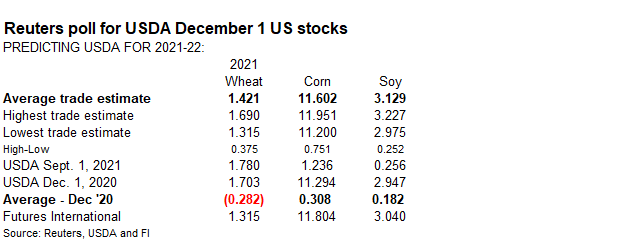
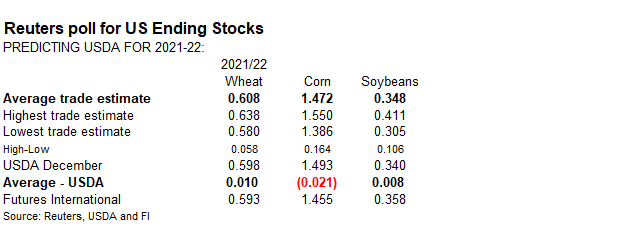


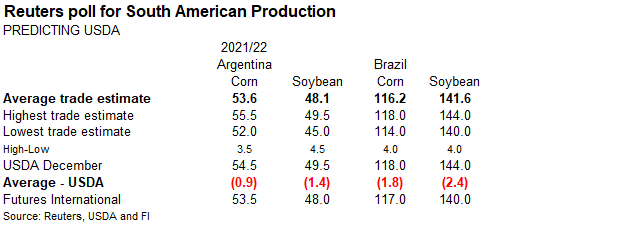

Bloomberg
trade estimates for the January USDA crop/stocks reports.






Macros
77
Counterparties Take $1.527 Tln At Fed Reverse Repo Op. (prev $1.560 Tln, 76 Bids)
EIA:
Brent Crude Oil Spot Prices Averaged $71 Per Barrel (B) In 2021, And We Forecast Brent Prices Will Average $75/B In 2022 And $68/B In 2023
–
U.S. Crude Oil Production Averaged 11.2 Million B/D In 2021. We Expect Production To Average 11.8 Million B/D In 2022 And To Rise To 12.4 Million B/D In 2023, Which Would Be The Highest Annual Average U.S. Crude Oil Production On Record. The Current Record
Is 12.3 Million B/D, Set In 2019
–
Crude Oil Production From OPEC Member Countries Averaged 26.3 Million B/D In 2021, Up From 25.6 Million B/D In 2020. We Forecast That Average OPEC Crude Oil Production Will Rise By 2.5 Million B/D To Average 28.8 Million B/D In 2022 And Average 28.9 In 2023
·
CBOT corn ended 0.50-1.25 cents higher on higher wheat and Conab lowering their Brazil corn production estimate by a more than expected 4.3 million tons to 112.9 million tons. The trade was looking for 115.7 million tons. This
compares to the low 87.05 million tons produced a year ago. Rain will develop across southern Brazil and Argentina later this week into next week and this kept a lid on gains.
·
Funds bought an estimated net 1,000 corn contracts.
·
Analysts on average expect the USDA to show December 1 corn stocks at a three-year high, up 2.7% from a year earlier. But for SA production, look for a drop in output. US 2021-22 ending stocks should decline from USDA’s December
outlook, but by a small amount.
·
U.S. Crude Oil Futures Settle At $81.22/bbl, Up $2.99, 3.82pc
·
Brent Crude Futures Settle At $83.72/bbl, Up $2.85, 3.52pct
·
UkrAgroConsult raised their Ukraine corn crop by 1.3 million tons to 40.5 million tons and exports to 33.8 million tons this season versus 32.7m tons previously.
·
Anec sees Brazil January corn shipments reaching 1.798 million tons in January versus 986,857 tons during January 2021.
·
China plans to keep their tariff in place for US DDGS while the China AgMin conducts a year long “review” on anti-dumping and anti-subsidy measures that will run from Jan 12 until Jan 12, 2023. Anti-dumping duties were raised
to 42.2%-53.7% in January 2017, while the anti-subsidy tariffs were raised to 11.2%-12% from 10.0%-10.7%.
·
US meat plant staff shortages are slowing meat production from rising Covid-19 infections. Over the past three weeks infections have spiked but recent US testing data shows it may have peaked last weekend.
Export
developments.
·
South Korea’s NOFI group bought 130,000 tons of feed corn all at an estimated $333.65 a ton c&f. One consignment was for arrival around April 1 and second for arrival around April 10. Offers for a third corn consignment for arrival
around April 30 were rejected.
·
South Korea’s KFA bought 129,000 tons of feed corn. One consignment of 66,000 tons was bought at $338.35 a ton c&f for arrival in South Korea around March 31. Another consignment of 63,000 tons was bought at $335.30 a ton c&f
for arrival in South Korea in late April.
·
Over the weekend The Korea Feed Association (KFA) bought around 130,000 tons of optional origin corn in two consignments each of about 65,000 tons, both at an estimated $334.17 a ton c&f. The first consignment was sought for arrival
around March 30 and second consignment was sought for arrival around April 20.
A
Positive Pig Report
Franken,
J. “A Positive Pig Report.” farmdoc daily (12):3, Department of Agricultural and Consumer Economics, University of Illinois at Urbana-Champaign, January 10, 2022.
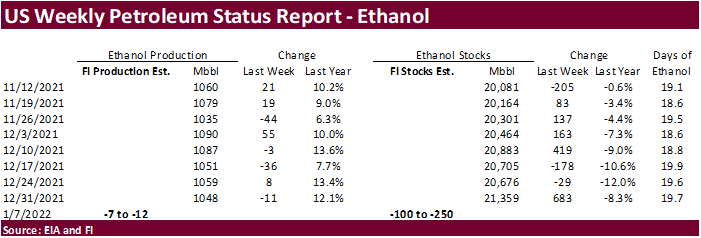
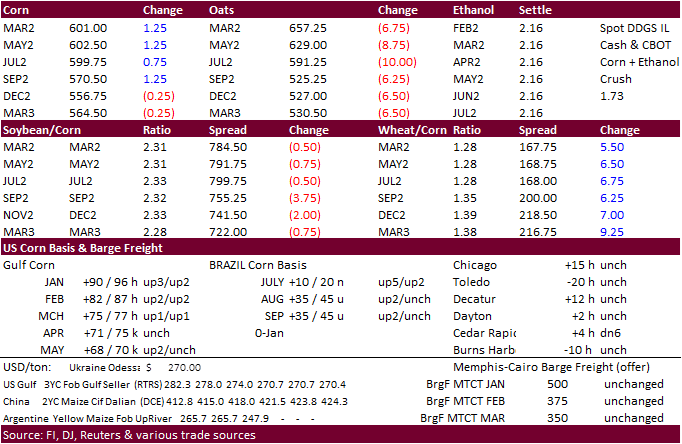
Updated
1/10/22
March
corn is seen in a $5.70 to $6.20 range
·
CBOT soybeans started lower on weakness in soybean meal and larger than expected Brazil soybean estimate but some found the dip to be a buying opportunity and with higher soybean oil, soybeans ended higher in the front four months.
March soybeans hit sell stops early after trading below its 10-day MA of 13.7475 (it has not traded below the 10-day since mid-December) but after fund selling dried, pricing lifted prices higher.
·
Conab reported a surprise for the Brazil soybean crop of 140.5 million tons, much higher than expected by 4.7MMT (135.8MMT average estimate) but still a record. Most of the trade sees the Brazil crop below 140 million tons. Conab
is historically slow to revise down their soybean crop in poor weather years, and with harvesting is less than one percent of the total crop the trade has a while to go to see a good picture of the size of the crop. The latest private estimate for Brazil was
136.24 million tons by PÁTRIA AgroNegócios, released today.
·
CBOT soybean meal ended lower while soybean oil traded higher on sharply higher WTI crude oil prices.
·
Funds bought an estimated net 1,000 soybeans, sold 1,000 soybean meal and bought 5,000 soybean oil.
·
Under the 24-hur announcement system, private exporters sold 100,000 tons of soybeans for delivery to Mexico during the 2021/2022 marketing year.
·
Argentina continues to have shipping problems along the Parana River with low water levels. They cut cargoes by about 30 percent leaving the Rosario hub.
·
Anec sees Brazil January soybean shipments reaching 4.274 million tons in January versus 53,644 tons during January 2021.
·
One analyst thinks Paraguay’s first soybean crop won’t even reach 6 million tons versus 9 million tons last year (9.4MMT total crop) due to poor yields from dry weather. Some producers see this year’s harvest the worst in decades.
Just over 30% of the first harvest is complete with most yields below 2,000 kilos per hectare.
·
Cargo surveyor SGS reported month to date January 10 Malaysian palm exports at 325,601 tons, 222,778 tons below the same period a month ago or down 40.6%, and 47,151 tons above the same period a year ago or up 16.9%.
·
Malaysian palm futures traded higher by 40 ringgit to 5,069, a 10-week high.
USDA
Attaché: Argentina 2021–22 soy crop at 46.5 million tons
Post
reduces its projected Marketing Year (MY) 2021/22 soybean production to 46.5 million
metric
tons (MMT), 3 MMT below USDA Official.
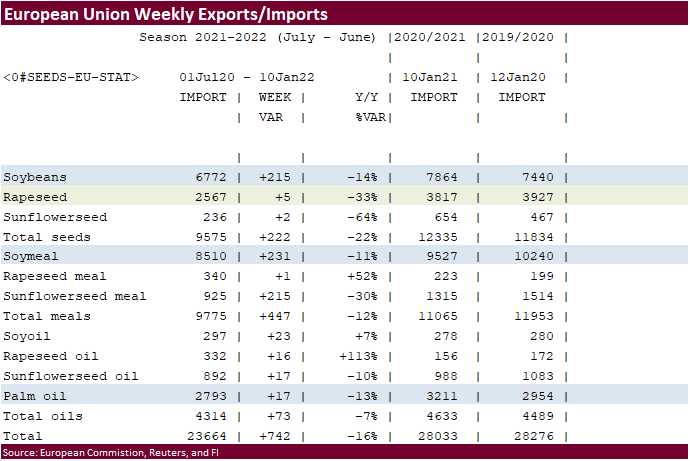
Export
Developments
·
Under the 24-hur announcement system, private exporters sold 100,000 tons of soybeans for delivery to Mexico during the 2021/2022 marketing year.
·
The USDA seeks 7,540 tons of vegetable oil in 4 liter cans for Feb 16-Mar 15 shipment on January 19.

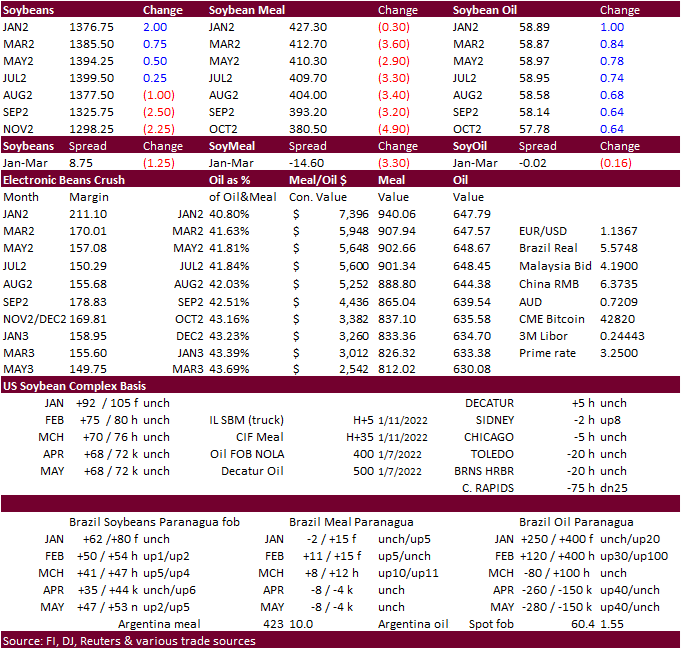
Updated
1/10/22
Soybeans
– March $13.00-$14.25
Soybean
meal – March $370-$435
Soybean
oil – March 54.50-61.00
·
US wheat ended higher led by HRW wheat on follow through short covering, increase in global wheat import demand and
a
weather forecast calling for dry conditions across the central and southern Great Plains. Some precipitation should develop by this time next week.
·
Funds bought an estimated net 5,000 SRW wheat contracts.
·
EU wheat basis the March position was 1.25 higher at 276.75 euros a ton.
·
Euronext launched their durum wheat futures contracts today, but we little interest.
·
(Reuters) – Japan’s weather bureau said on Tuesday the La Nina phenomenon is continuing and that there is an 80% chance it will prevail through the end of the Northern Hemisphere winter and an 80% chance the conditions will end
in spring.
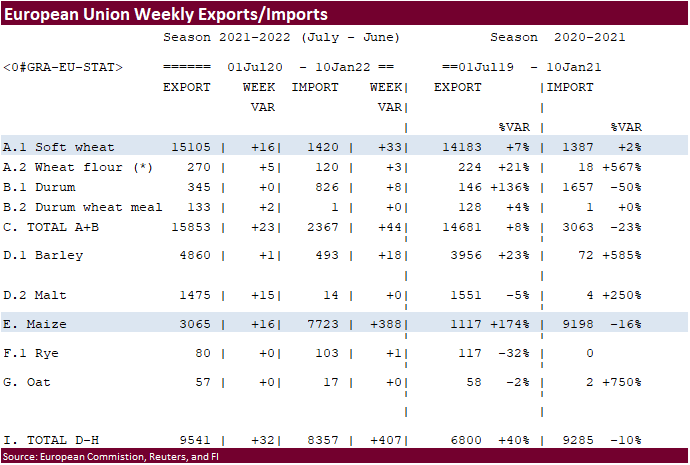
·
Algeria seeks milling wheat on January 13 for FH March shipment.
·
South Korea’s MMFG bought 55,000 tons of Australia feed wheat at $334/ton c&f for shipment between February 15 and March 15.
·
Turkey seeks 335,000 tons of milling wheat on January 18.
·
Iran’s GTC seeks milling wheat for Feb-Mar shipment.
·
South Korea’s NOFI rejected all offers for 65,000 tons of feed wheat for arrival around April 25. Lowest feed wheat offer was said to be $341.50 a ton c&f.
·
Japan seeks 107,555 tons of milling wheat this week.
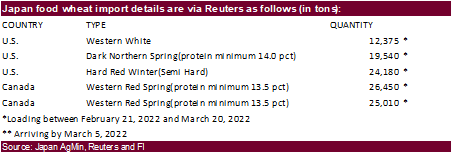
·
China plans to sell 500,000 tons of wheat from state reserves on January 12 to flour millers.
·
Iraq extended their deadline for 50,000 tons of wheat, set to now close on January 13 instead of the 3rd, from the US, Canada and Australia.
·
Jordan seeks 120,000 tons of wheat on January 18. Possible shipment combinations are in 2022 between July 1-15, July 16-31, Aug. 1-15 and Aug. 16-31.
Rice/Other
·
(Bloomberg) — U.S. 2021-22 cotton ending stocks seen as 3.46m bales, slightly above USDA’s previous est., according to the avg in a Bloomberg survey of seven analysts. Estimates range from 3.0m to 3.85m bales. Global ending
stocks seen 125,000 bales lower at 85.61m bales.
·
Bangladesh seeks 50,000 tons of rice on January 16.
Reuters:
“In the past 22 Januarys, the trade average for winter wheat acres was below the reported figure only five times. But three of those instances occurred in the last four years, consistent with the leveling off in plantings after a steep decline mid-last decade.”
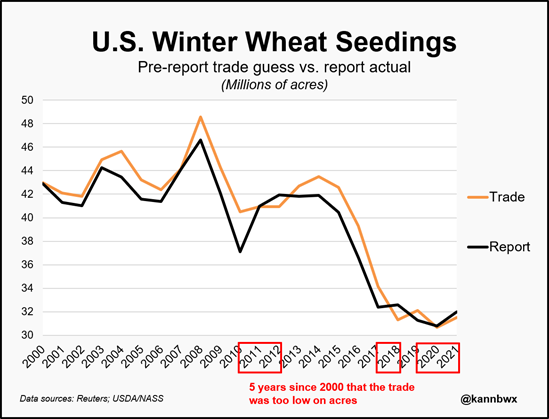
Source:
Reuters
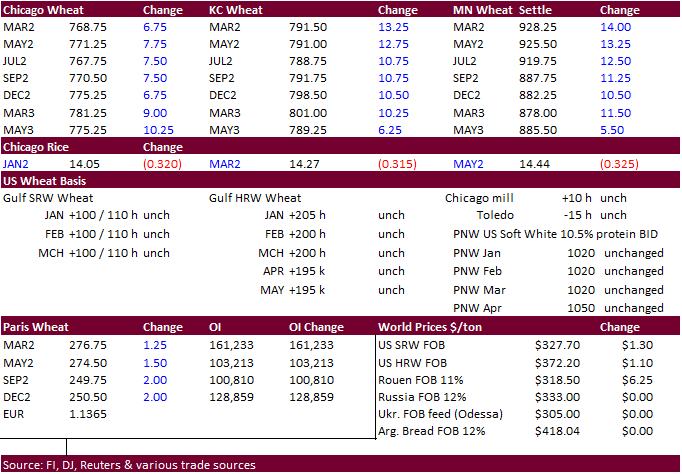
Updated
1/10/22
Chicago
March $7.20 to $8.40 range
KC
March $7.55 to $8.75 range
MN
March $8.75‐$10.00
Terry Reilly
Senior Commodity Analyst – Grain and Oilseeds
Futures International
One Lincoln Center
18 W 140 Butterfield Rd.
Oakbrook Terrace, Il. 60181
W: 312.604.1366
ICE IM:
treilly1
Skype: fi.treilly

Trading of futures, options, swaps and other derivatives is risky and is not suitable for all persons. All of these investment products are leveraged, and you can lose more than your initial deposit. Each investment product is offered
only to and from jurisdictions where solicitation and sale are lawful, and in accordance with applicable laws and regulations in such jurisdiction. The information provided here should not be relied upon as a substitute for independent research before making
your investment decisions. Futures International, LLC is merely providing this information for your general information and the information does not take into account any particular individual’s investment objectives, financial situation, or needs. All investors
should obtain advice based on their unique situation before making any investment decision. The contents of this communication and any attachments are for informational purposes only and under no circumstances should they be construed as an offer to buy or
sell, or a solicitation to buy or sell any future, option, swap or other derivative. The sources for the information and any opinions in this communication are believed to be reliable, but Futures International, LLC does not warrant or guarantee the accuracy
of such information or opinions. Futures International, LLC and its principals and employees may take positions different from any positions described in this communication. Past results are not necessarily indicative of future results.

